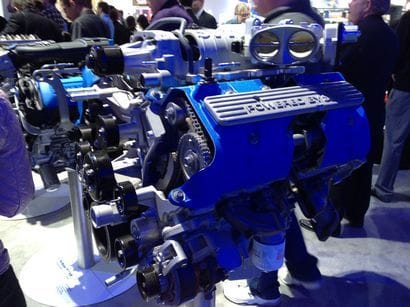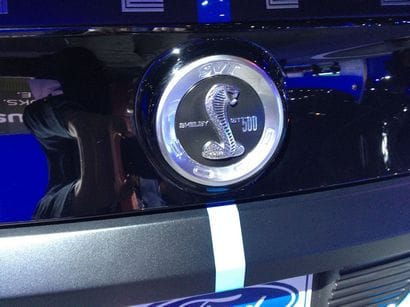Ford proclaims the 2013 Shelby GT500 to be the most powerful production V8 in the world

Take that, Camaro
As Antoine Dodson might say, “Hide yo kids, hide yo wife and hide yo husband.”
Earlier today, Ford Motor Company announced the official SAE certification for the 5.8-liter supercharged V8 that will appear in the 2013 Ford Shelby GT500.
Built at the company’s AutoAlliance International Plant in Flat Rock, Michigan, when it reaches Ford new car dealers this fall it will officially be generating 662 horsepower along with a massive 631 lb.-ft. of torque.

Ford notes that even with an additional 112 horses on tap versus the 2012 GT500, fuel efficiency is up by 1 mpg for both the city and highway EPA numbers when compared to the outgoing model, making it the most fuel efficient vehicle in its segment as well as the most fuel-efficient car with over 550 horsepower in any segment available in the U.S. of A.
The company is also quick to point out that their latest tarmac melter also bests the Chevrolet Camaro ZL1 by 5 mpg on the highway, even as it leapfrogs the bowtie’s LSA V8 by 82 horsepower and 75 lb.-ft. of torque noting that “With the 2013 GT500 world-class performance no longer has to mean a world-class thirst for fuel.”

Specifics
"Our goal is to create outstanding all-around performance cars, not just stoplight-to-stoplight sprinters," said Jamal Hameedi, SVT chief engineer. "We've backed up this amazing powerplant with a more refined chassis tuning that helps keep the rubber on the pavement without punishing the driver's spine and six-pot Brembo brakes that dissipate speed with ease stop after stop."
To that end, more than ninety percent of peak torque is available between 2,200 and 5,800 rpm, with 395 lb.-ft. on tap off-idle at 1,000 rpm.

With that much torque and a maximum velocity north of 200 miles per, SVT engineers concentrated on tuning the chassis to absorb road imperfections that can cause instability at high speeds. In addition, a revised front end and splitter give the newest GT500 33 percent more aero loading at 160 mph than the 2011 model. Yee-ha!
"The engineers at Ford SVT focused on the fundamentals first with solid mechanical grip and strong brakes," added Hameedi. "On top of that platform they added advanced driver-adjustable electronic assist features including launch control, Bilstein adjustable damping, AdvanceTrac stability control and electric power-assisted steering."














